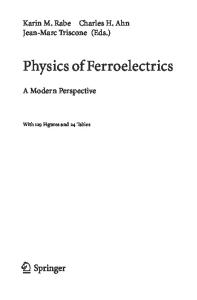Ferroelectrics and Antiferroelectrics
Ferroelectric crystals (especially oxides in the form of ceramics) are important basic materials for technological applications in capacitors capacitor and in piezoelectric, pyroelectric, and optical devices. In many cases their nonlinear characteristics
- PDF / 5,094,168 Bytes
- 36 Pages / 547.146 x 686 pts Page_size
- 32 Downloads / 348 Views
Ferroelectrics
Matter consists of electrons and nuclei. Most of the electrons generally are tightly bound to the nuclei, but some of the electrons are only weakly bound or are freely mobile in a lattice of ions. The physical properties of matter can be considered as being split into two categories. The properties in the first category are determined directly by the electrons and by the interaction of the electrons with lattice vibrations. Examples are the metallic, magnetic, superconductive, and semiconductive properties. The properties in the second category are only indirectly related to the electrons and can be discussed as being due
4.5.1 Definition of Ferroelectrics and Antiferroelectrics ......................... 903 4.5.2 Survey of Research on Ferroelectrics ..... 904 4.5.3 Classification of Ferroelectrics .............. 906 4.5.3.1 The 72 Families of Ferroelectrics 909 4.5.4 Physical Properties of 43 Representative Ferroelectrics ..................................... 4.5.4.1 Inorganic Crystals Oxides [5.1, 2] 4.5.4.2 Inorganic Crystals Other Than Oxides [5.3] ............ 4.5.4.3 Organic Crystals, Liquid Crystals, and Polymers [5.4] ..................
912 912 922 930
References .................................................. 936
consists of three subvolumes: Subvolume A [5.1, 2], covering oxides; Subvolume B [5.3], covering inorganic crystals other than oxides; and Subvolume C [5.4], covering organic crystals, liquid crystals, and polymers.
to interaction between atoms, ions, or molecules. In this category we have, for example, the dielectric, elastic, piezoelectric, and pyroelectric properties; we have the dispersion relations of the lattice vibrations; and we have most of the properties of liquid crystals and polymers. The important properties of ferroelectrics are linked to all the latter properties, and they exhibit diverse types of phase transitions together with anomalies in these properties. These specific modifications convey information about cooperative interactions among ions, atoms, or molecules in the condensed phase of matter.
4.5.1 Definition of Ferroelectrics and Antiferroelectrics A ferroelectric crystal is defined as a crystal which belongs to the pyroelectric family (i. e. shows a spontaneous electric polarization) and whose direction of spontaneous polarization can be reversed by an electric
field. An antiferroelectric crystal is defined as a crystal whose structure can be considered as being composed of two sublattices polarized spontaneously in antiparallel directions and in which a ferroelectric phase can
Part 4 5
Ferroelectric crystals (especially oxides in the form of ceramics) are important basic materials for technological applications in capacitors and in piezoelectric, pyroelectric, and optical devices. In many cases their nonlinear characteristics turn out to be very useful, for example in optical second-harmonic generators and other nonlinear optical devices. In recent decades, ceramic thinfilm ferroelectrics have been utilized intensively as parts of memory devic
Data Loading...











